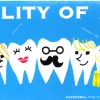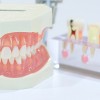【85th Blog】Support parents with medical insurance coverage for teeth alignment treatment for children
- Orthodontic treatment still a pricy expense
Household incomes have grown stagnant, but orthodontic treatment is still a costly expense, averaging at 850,000 JPY across the country. 40% of children have been diagnosed with an incorrect bite, known as malocclusion. It is also reported that 1 in 6 children are living in households below the poverty line. Meaning that many parents who want to send their children to get treatment cannot afford the expensive treatment, and as a result their children develop with an incorrect bite. This is a reality for many children in Japan.
- Delayed penetration in Japan
Treatment to get your teeth straightened is completely normal for children all around the world. Crooked teeth are viewed as something that holds you back, and can even hinder some from getting into certain lines of work. Teeth alignment treatment is common practice, and general consensus from society is that it is parents’ responsibility to see that their children receive any needed treatment. However, according to the OECD, Japan has a very low penetration rate when it comes to orthodontic treatment compared to other countries. Penetration in Japan has stalled at one-fifth of that in the US, and one-third of the rate in Europe and Korea. This is despite a sudden surge in the practice of orthodontics in Southeast Asia and China in recent years.
- Orthodontic treatment not covered by insurance in Japan
Provision of teeth alignment treatment varies depending from country to country, but in OECD member countries 20-40% of children with incorrect bites undergo orthodontic treatment free of charge. Those who qualify for free treatment under public health insurance schemes are mostly children from low income households or those with severe malocclusions. In Japan, orthodontics that includes fracturing jaws and realigning facial bones carried out by surgeons is covered by public health insurance. But a closer look reveals that the proportion of children who require this kind of treatment is only a minute percentage of the overall numbers. In recent years, awareness of orthodontic treatment and the number of families bearing the cost of treatment for their children is increasing. It is estimated that those undergoing treatment at their own expense is 10-15% of all children who get treatment. Across OECD member countries, 40-60% of all children undergo orthodontic treatment.
- Learning from the British System
We must take a closer look at why such a difference in the provision of orthodontic care exists. Japan based its public health insurance system on Great Britain who were also behind their European counterparts in terms of orthodontic treatment diffusion until they reformed their orthodontic treatment system in 2006. It has expanded greatly since then, bringing them up to par with their European neighbours. What had been a treatment rate of 20% doubled in size to 40% almost instantly. According to the Index of Orthodontic Treatment Need (IOTN), a body that assess cases covered by public health insurance, the rate of treatment coverage reached as high as 65%. For more details, please see the IOTN’s chart (http://amapolaortho2.org/post-846/) on the proposal website. Grades 4 and 5 are covered as would be expected, as well as grade 3 as seen on this chart. While coverage by Japan’s public health system is still stalling at a mere few percent.
- There’s more to straight teeth than looking good
A correct bite aids proper mastication (chewing and digestion of food), leading to overall physical health, the ability to annunciate and converse clearly, and instills self-affirmation. Furthermore, being able to chew with your own teeth for as long as possible in life also has a positive impact on one’s Quality of Life (QOL). Even if everyone were aware of the importance of teeth alignment, and wanted to have a correct bite, the reality is that orthodontic treatment is out of reach for many. It’s unthinkable that in an age where there is free movement of people between countries that Japanese people alone should be held back by poorly aligned teeth. We believe that if health insurance coverage is expanded to include even just grade 4 and 5 as designated by the IOTN, then we will be making a step in the right direction towards solving this problem.
- Supporting parents in proportion to health insurance costs
Health insurance rates are calculated at approximately 10% of a person’s salary in Japan. This is by no means a low rate compared to other countries. Hence, it is only natural that we would want to receive the same level of public subsidisation for orthodontic treatment for children in Japan as is commonplace in other OECD countries. We are seeking free orthodontic treatment paid by public health insurance as a part of medical welfare of children diagnosed with grade 4 malocclusion or worse, and as a form of parental assistance for children in low income households. If it is possible to establish such a subsidy, then heightened awareness of orthodontics will be created throughout the country, enabling Japan to close in on the 20-30% penetration rate of other OECD countries.












